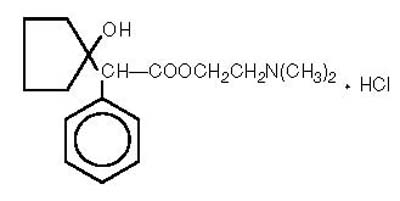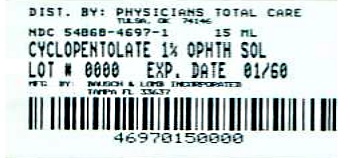CYCLOPENTOLATE HYDROCHLORIDE solution/ drops
Cyclopentolate Hydrochloride by
Drug Labeling and Warnings
Cyclopentolate Hydrochloride by is a Prescription medication manufactured, distributed, or labeled by Physicians Total Care, Inc.. Drug facts, warnings, and ingredients follow.
Drug Details [pdf]
- SPL UNCLASSIFIED SECTION
-
DESCRIPTION:
Cyclopentolate Hydrochloride Ophthalmic Solution USP, 1% is an anticholinergic prepared as a sterile, borate buffered, solution for topical ocular use. The active ingredient is represented by the following structural formula:

C17H25NO3 HCl
Mol. Wt. 327.85Chemical name: 2-(Dimethylamino) ethyl 1-hydroxy-α-phenylcyclopentaneacetate hydrochloride.
Each mL Contains:
ACTIVE: Cyclopentolate Hydrochloride, 10 mg (1%)
INACTIVES: Boric Acid, Potassium Chloride, Edetate Disodium, Purified Water. Sodium Carbonate and/or Hydrochloric Acid may be added to adjust pH (3.0-5.5).
PRESERVATIVE ADDED: Benzalkonium Chloride 0.01%.
-
CLINICAL PHARMACOLOGY:
This anticholinergic preparation blocks the responses of the sphincter muscle of the iris and the accommodative muscle of the ciliary body to cholinergic stimulation, producing pupillary dilation (mydriasis) and paralysis of accommodation (cycloplegia). It acts rapidly, but has a shorter duration than atropine. Maximal cycloplegia occurs within 25 to 75 minutes after instillation. Complete recovery of accommodation usually takes 6 to 24 hours. Complete recovery from mydriasis in some individuals may require several days.
- INDICATIONS AND USAGE:
- CONTRAINDICATIONS:
-
WARNINGS:
For Topical Use Only - Not For Injection. This preparation may cause CNS disturbances. This is especially true in younger age groups, but may occur at any age, especially with the stronger cyclopentolate hydrochloride solution. Premature and small infants are especially prone to CNS and cardiopulmonary side effects from systemic absorption of cyclopentolate. To minimize absorption, use only 1 drop of a 0.5% solution per eye followed by pressure applied over the nasolacrimal sac for two to three minutes. Observe infants closely for at least 30 minutes following instillation.
-
PRECAUTIONS:
General:
To avoid inducing angle closure glaucoma, an estimation of the depth of the angle of the anterior chamber should be made. The lacrimal sac should be compressed by digital pressure for two to three minutes after instillation to avoid excessive systemic absorption. Caution should be observed when considering use of this medication in the presence of Down’s syndrome or mongolism, and in those predisposed to angle-closure glaucoma.
Information for Patients:
Do not touch dropper tip to any surface as this may contaminate the solution. A transient burning sensation may occur upon instillation. Patients should be advised not to drive or engage in other hazardous activities while pupils are dilated. Patients may experience sensitivity to light and should protect eyes in bright illumination during dilation. Parents should be warned not to get this preparation in their child’s mouth and to wash their own hands and the child’s hands following administration.
Drug Interactions:
Cyclopentolate may interfere with the antiglaucoma action of carbachol or pilocarpine; also, concurrent use of these medications may antagonize the anti-glaucoma and miotic actions of ophthalmic cholinesterase inhibitors.
Carcinogenesis, Mutagenesis, Impairment of Fertility:
Studies in animals or humans have not been conducted to evaluate the potential of these effects.
Pregnancy Category C:
Animal reproduction studies have not been conducted with cyclopentolate. It is also not known whether cyclopentolate can cause fetal harm when administered to a pregnant woman or can affect reproduction capacity. Cyclopentolate should be administered to a pregnant woman only if clearly needed.
Nursing Mothers:
It is not known whether this drug is excreted in human milk. Because many drugs are excreted in human milk, caution should be exercised when cyclopentolate hydrochloride is administered to a nursing woman.
Pediatric Use:
Increased susceptibility to cyclopentolate has been reported in pediatric patients with spastic paralysis or brain damage. Therefore, cyclopentolate should be used with great caution in these patients. Feeding intolerance may follow ophthalmic use of this product in neonates. It is recommended that feeding be withheld for four (4) hours after examination. Do not use concentrations higher than 0.5% in small infants (see WARNINGS).
-
ADVERSE REACTIONS:
Ocular: Increased intraocular pressure, burning, photophobia, blurred vision, irritation, hyperemia, conjunctivitis, blepharoconjunctivitis, punctate keratitis, synechiae.
Systemic: Use of cyclopentolate has been associated with psychotic reactions and behavioral disturbances, usually in pediatric patients, especially with a 2% concentration. These disturbances include ataxia, incoherent speech, restlessness, hallucinations, hyperactivity, seizures, disorientation as to time and place, and failure to recognize people. This drug produces reactions similar to those of other anticholinergic drugs, but the central nervous system manifestations as noted above are more common. Other toxic manifestations of anticholinergic drugs are skin rash, abdominal distention in infants, unusual drowsiness, tachycardia, hyperpyrexia, vasodilation, urinary retention, diminished gastrointestinal motility and decreased secretion in salivary and sweat glands, pharynx, bronchi and nasal passages. Severe manifestations of toxicity include coma, medullary paralysis and death.
-
OVERDOSAGE:
Excessive dosage may produce exaggerated symptoms as noted in ADVERSE REACTIONS. When administration of the drug product is discontinued, the patient usually recovers spontaneously. In case of severe manifestations of toxicity the antidote of choice is physostigmine salicylate.
Pediatric Dose: As an antidote, slowly inject intravenously 0.5 mg physostigmine salicylate. If toxic symptoms persist and no cholinergic symptoms are produced repeat at five minute intervals to a maximum cumulative dose of 2 mg.
Adolescent and Adult: As an antidote, slowly inject 2 mg physostigmine salicylate intravenously. A second dose of 1 to 2 mg may be given after 20 minutes if no reversal of toxic manifestations has occurred. 1, 2, 3
-
DOSAGE AND ADMINISTRATION:
Adults: One or two drops of 0.5%, 1% or 2% solution in the eye, which may be repeated in five to ten minutes if necessary. Complete recovery usually occurs in 24 hours.
Pediatric Patients: One or two drops of 0.5%, 1% or 2% solution in the eye, which may be repeated five to ten minutes later by a second application of 0.5% or 1% solution if necessary.
Small Infants: A single instillation of one drop of 0.5% solution in the eye. To minimize absorption, apply pressure over the nasolacrimal sac for two to three minutes. Observe infant closely for at least 30 minutes following instillation.
Individuals with heavily pigmented irises may require higher strengths.
-
HOW SUPPLIED:
Cyclopentolate Hydrochloride Ophthalmic Solution USP, 1% is available in multidose plastic squeeze bottles with a controlled drop tip and red cap in the following sizes:
15 mL bottle - Prod. No. 04911 NDC: 54868-4697-1
-
REFERENCES
1. Rumack, B.H.: Anticholinergic Poisoning: Treatment with Physostigmine. Pediatrics 52(6): 449-51, 1973.
2. Duvoisin, R.C. and Katz, R.: Reversal of Central Anticholinergic Syndromes in Man by Physostigmine, J. Am. Med. Assn. 206(9): 1963-65,1968.
3. Grant, W.M.: Toxicology of the Eye. Second Edition, Volume 1. Springfield, Illinois, Charles C. Thomas: 1974.
Revised November 2007
- SPL UNCLASSIFIED SECTION
-
PACKAGE/LABEL PRINCIPAL DISPLAY PANEL

NDC: 54868-4697-1
Cyclopentolate Hydrochloride Ophthalmic Solution USP, 1% (Sterile)
Rx only
[icon- eye] [icon- 1%] [icon- solution] [icon- 15 mL]
-
INGREDIENTS AND APPEARANCE
CYCLOPENTOLATE HYDROCHLORIDE
cyclopentolate hydrochloride solution/ dropsProduct Information Product Type HUMAN PRESCRIPTION DRUG Item Code (Source) NDC: 54868-4697(NDC:24208-735) Route of Administration OPHTHALMIC Active Ingredient/Active Moiety Ingredient Name Basis of Strength Strength CYCLOPENTOLATE HYDROCHLORIDE (UNII: 736I6971TE) (CYCLOPENTOLATE - UNII:I76F4SHP7J) CYCLOPENTOLATE HYDROCHLORIDE 10 mg in 1 mL Inactive Ingredients Ingredient Name Strength BENZALKONIUM CHLORIDE (UNII: F5UM2KM3W7) BORIC ACID (UNII: R57ZHV85D4) EDETATE DISODIUM (UNII: 7FLD91C86K) HYDROCHLORIC ACID (UNII: QTT17582CB) POTASSIUM CHLORIDE (UNII: 660YQ98I10) WATER (UNII: 059QF0KO0R) SODIUM CARBONATE (UNII: 45P3261C7T) Packaging # Item Code Package Description Marketing Start Date Marketing End Date 1 NDC: 54868-4697-1 1 in 1 CARTON 1 15 mL in 1 BOTTLE, DROPPER Marketing Information Marketing Category Application Number or Monograph Citation Marketing Start Date Marketing End Date ANDA ANDA040075 01/10/2013 Labeler - Physicians Total Care, Inc. (194123980) Establishment Name Address ID/FEI Business Operations Physicians Total Care, Inc. 194123980 relabel(54868-4697)
© 2025 FDA.report
This site is not affiliated with or endorsed by the FDA.